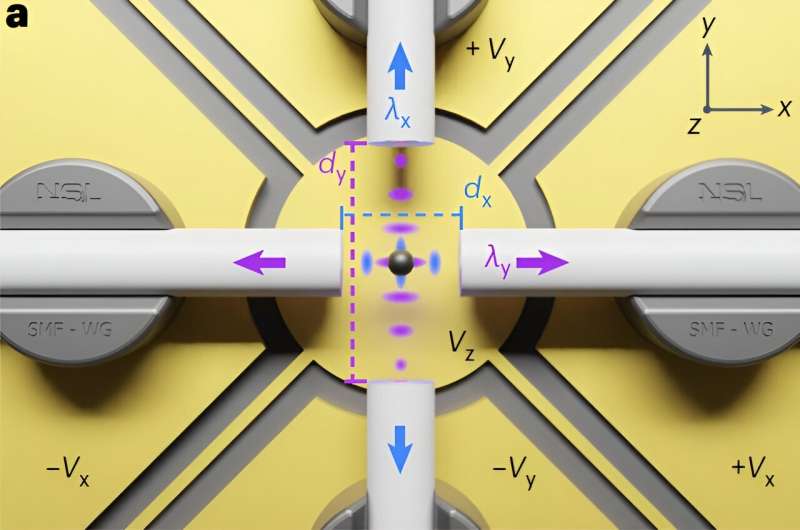
The team’s on-chip levitation platform. a, The top optical layer consists of two orthogonal pairs of cleaved single-mode optical fibers. One of the pairs (along y) creates a standing wave at λy = 1550 nm, while the second pair (along x) creates a standing wave at λx = 1064 nm. The distances between the fibers are dx = 80 μm and dy = 160 μm. A particle (black) is trapped at the intersection of the two standing waves. The light scattered by the particle in the fibers, represented by the arrows, is used for displacement detection. The four fibers are positioned above a set of planar electrodes used to apply active feedback cooling to the charged particle via electrical forces: right and left electrodes for x-axis feedback, top and bottom electrodes for y-axis feedback, and center electrode for z-axis feedback. b, Image of the levitation chip showing the planar electrodes, the four optical fibers, the fiber supports near the center, and the wire bonds from the chip to the PCB at the corners. c, Optical fiber positioned in a mechanical holder fabricated by two-photon polymerization and used to align and hold the fibers in place. Credit:Natural nanotechnology (2024). DOI: 10.1038/s41565-024-01677-3
Levitation of microscopic objects in a vacuum and control of their motions while suspended were first demonstrated several decades ago. Since then, various research groups have been working on new approaches to control levitating objects in a vacuum with higher degrees of freedom.
While most of the experiments conducted so far have relied on optical techniques, some teams have recently started using hybrid experimental platforms that combine concepts from atomic physics. These hybrid platforms allow for better control of the motion of levitating objects, opening up new possibilities, such as force and torque detection or precision acceleration.
Researchers at ETH Zurich have recently demonstrated the high-vacuum levitation of a silica nanoparticle on a hybrid photonic-electric chip. Their proposed experimental platform, described in a paper published in Natural nanotechnologyhas been shown to enable robust levitation, precise position sensing and dynamic control of the nanoparticle in vacuum.
“By isolating mesoscopic objects from the environment and precisely controlling them, vacuum levitation has become a versatile technique that has already benefited diverse scientific directions, from force sensing and thermodynamics to materials science and chemistry,” wrote Bruno Melo, Marc T. Cuairan and their colleagues in their paper.
“This also holds great promise for advancing the study of quantum mechanics in the unexplored macroscopic regime.”
Despite recent advances in the field of vacuum levitation and particle motion control, most experimental methods introduced so far rely on complex strategies and/or bulky equipment. This significantly limits their practical applications, making them impractical for the development of new technologies.
Some researchers have attempted to miniaturize vacuum levitation platforms using electrostatic and optical traps. However, the levitation obtained using most of the proposed approaches was not robust enough to be applied to confined devices, such as cryostats and portable devices.
Melo, Cuairan, and collaborators presented a novel hybrid photonic-electric platform that enables robust levitation, position sensing, and dynamic control of a nanoparticle on a chip. Unlike other platforms, their proposed method does not require bulky lenses or optical equipment.
“We demonstrate the levitation and control of the high-vacuum motion of a silica nanoparticle on the surface of a hybrid optical-electrostatic chip,” Melo, Cuairan, and colleagues wrote. “By combining fiber-based optical trapping and sensitive position sensing with cold damping by planar electrodes, we cool the particle motion to a few hundred phonons.”
In early testing, the team’s proposed on-chip vacuum levitation and motion control platform achieved remarkable results, with signal-to-noise ratios and optical displacement detection capabilities comparable to other approaches that rely on bulky optical equipment. By combining their platform with planar electrodes for active feedback cooling, the researchers were also able to cool the silica nanoparticle and reduce its 3D motion.
The new approach of vacuum levitation and on-chip motion control introduced by this ETH Zurich team could soon open new perspectives for quantum research and technology development. In their future studies, Melo, Cuairan and their colleagues plan to continue improving their platform, for example by using refractive microlenses to further improve its detection sensitivity and by integrating more sophisticated optical elements (e.g., fiber cavities).
“We envision our fully integrated platform to be the starting point for on-chip devices combining integrated photonics and nanophotonics with precisely designed electrical potentials, improving the control of particle motion toward the preparation and readout of complex states,” Melo, Cuairan and colleagues wrote.
More information:
Bruno Melo et al, Vacuum Levitation and On-Chip Motion Control, Natural nanotechnology (2024). DOI: 10.1038/s41565-024-01677-3
© 2024 Science X Network
Quote:Demonstration of vacuum levitation and motion control on an optical-electrostatic chip (2024, July 2) retrieved July 2, 2024 from https://phys.org/news/2024-07-vacuum-levitation-motion-optical-electrostatic.html
This document is subject to copyright. Apart from any fair dealing for the purpose of private study or research, no part may be reproduced without written permission. The content is provided for informational purposes only.